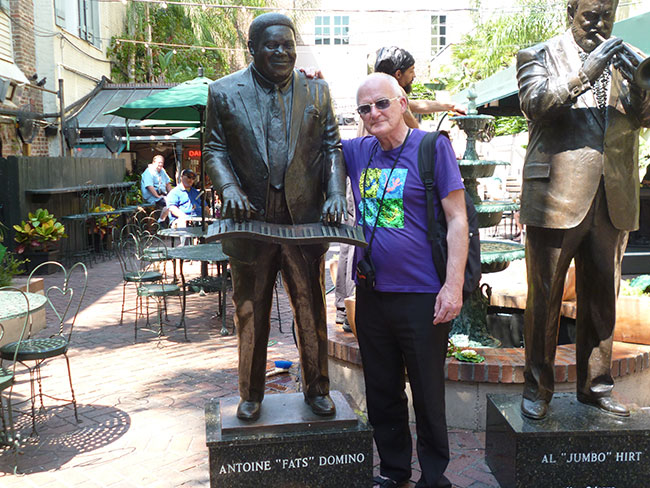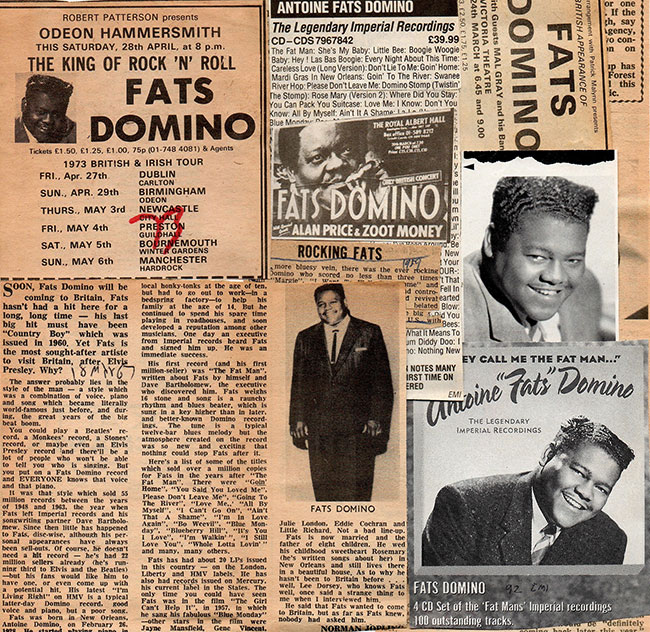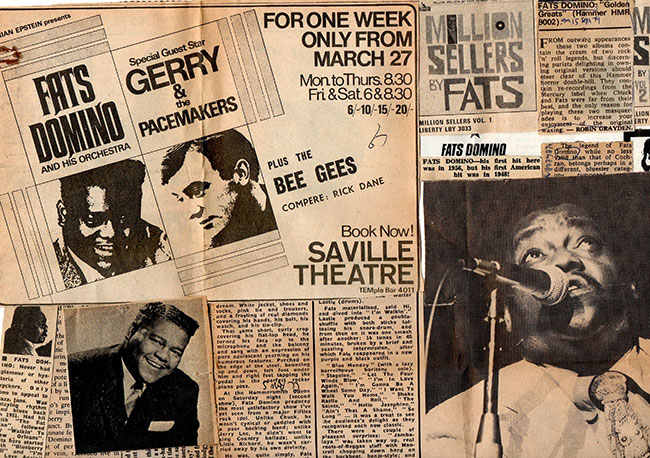
Antoine Dominique ‘Fats’ Domino Jr
26 February 1928-24 October 2017
Elvis would never have recorded “Blueberry Hill” if he hadn’t heard Fats Domino doing it first.
When Pat Boone’s version of “Ain’t That A Shame” gave him his first Billboard no.1, the Fats Domino original stalled at no.10 beneath it. But as Little Richard later explained about “Tutti Frutti”, white kids bought the blemish-free Boone version to placate Mom and Pop, while they kept the wilder black original out of sight in their room. And as Fats later sang it, ‘I’m the king, but you can wear my crown…’
A teenage John Lennon learned to play “Ain’t That A Shame” too, as the Fats Domino single, issued on the back-and-silver London-American label, reached the UK no.23 (2 February 1957, with “Blueberry Hill” in the Top ten above it). Lennon finally got to record his own take on the song on his 1975 ‘Rock ‘n’ Roll’ album. Oddly enough Fats himself recorded Lennon’s “Everybody’s Got Something To Hide Except Me And My Monkey” in 1969, alongside a bunch of other Beatles songs. Fats protested he couldn’t understand the lyrics, they make no sense, but he recorded it anyway. And it works. After a fashion.
Fats Domino’s debut single was “The Fat Man” issued on Imperial Records in December 1949, crossing over onto the charts during the early months of the new decade. A long pumping-boogie piano lead-in, raw stripped-down piano triplets, with the left-hand emphasising the rolling anchor-beat, lyrics that less defy political-correctness – ‘they call… they call me the fat man, ‘cos I weigh two-hundred pounds’ as celebrating it – ‘all the girls, they love me, ‘cos I know my way around’, then scatting into a soaring nasal near-falsetto ‘WAWA-WAA WAWA’ refrain that goes ‘WAWA-WAAAA-WAWAWA WAWA-WAAAWA-WAWA-WAWA WAWAAAAAAA-WA WAWAWAAAA-WAWA WAWA-WAAAAWA-WA WAWAWA’. It was creatively bowdlerised by Fats from a traditional low-rent Storyville eight-bar Blues, in league with long-term collaborator Dave Bartholomew, alongside heavyweight studio back-up from Earl Palmer’s solid drums. ‘It was a song they used to sing around New Orleans for years. We just changed the words a little’ he told Max Jones (‘Melody Maker’ April 1967). There were three US R&B listings at the time, ‘Race Records’ based on Best Sellers, Juke-Box Plays and Disc-Jockey radio airplay. He scored across all three, jumping jive on the big Diner chrome-gleaming Wurlitzer, or blasting in across crackly valve-radio airwaves. And it’s not so much that the big 78rpm disc invented Rock ‘n’ Roll, more that, after a series of highly rated follow-up records, they finally got around to devising a name for what he’d been doing all along.

Fats was never the wild man. ‘I’m gonna sing, my band gonna play…’ that’s all he needed to do. He never climbed up atop of his piano, never played licks with his expensively-shod feet, or sat his ample butt on the keyboard like Jerry Lee or Mr Penniman. Never subversive or dangerous, he never shocked or outraged morality with a hellfire private life, yet his hits were an irresistible part of the background soundtrack of the years. He simply overflowed the piano-stool, rolling to the rhythm, pumping the keys with chubby ring-encrusted bling-fingers, grinning a great mile-wide grin, his hair like ripples of blowtorched vinyl. A honeyed vocal delivery, less so than – say Nat King Cole, but a way of curling the notes in around the melody-line, pushing it, cajoling it with lubricious energy. Not for nothing had French been his first language. New Orleans was in his bloodstream. Fermented in the Creole, Cajun, Jazz and Blues gumbo of the blue-collar Lower Ninth Ward of the Crescent City, the son of a violinist, his uncle – Harry Verette, had played trumpet with Kid Ory’s legendary jazz-band. Young Antoine played honky-tonks and roadhouses for pocket-money, before graduating to teenage ivory-pounder at the ‘Hideaway Club’ with Billy Diamond’s Solid Senders, when he was hauled into Cosimo Matassa’s Rampart Street studio for “The Fat Man”.
Imperial records was founded by Lew Chudd in Hollywood in 1947, and Fats soon became the label’s best-selling and highest-grossing artist – until they signed Ricky Nelson (from Verve) after he’d sold a million with his cover of Fats’ “I’m Walkin’”. Over the following decade Fats seldom wandered far from his musical or geographical base. He didn’t need to. It was all there already. He couldn’t fail, and he didn’t! With his regular band, two or three saxes (Herb Hardesty, then Lee Allen), guitar (Walter Nelson or Ernie McLean), bass (Frank Fields) and drums (Cornelius Coleman), with songs largely written and arranged with trumpeter David Bartholomew – but for notable covers “Blueberry Hill”, “My Blue Heaven” or “Margie”, his relaxed, slightly lugubrious effortless roll could do no wrong. While he also found time to play sessions for Smiley Lewis, Joe Turner and Lloyd Price (“Lawdy Miss Clawdy”).

Favourites? “Blue Monday”, due to its performance in ‘The Girl Can’t Help It’ (1956) movie, the only opportunity UK audiences got to see him live, in a sequence that holds its own against incandescent Little Richard, Eddie Cochran and Gene Vincent clips, where the bare-foot flared-dress girls bop at the hop, and Herbert Hardesty’s rasping barrelhouse baritone sax-break flies high. Then the jerky jumpy knock-knock frantic-pacing of “I’m Walkin’”, showcasing Bartholomew’s complex twitching rhythm arrangement. Or the plucked rain effects and strings highlighting Fat’s melancholy twenty-second and final million-seller, “I’m Walking To New Orleans” – because ‘New Orleans is my home…’
Later, as styles, fads and fashions jostle around him, jumping trend, Fats records a full-bodied “The Domino Twist (Dance With Mr Domino)” in August 1962. Which is ironic. Because Chubby Checker adapted his name from Fats/Chubby Domino/Chequers. And as the first great Rock ‘n’ Roll wave hit the doldrums, Fats label-hopped, perhaps unwisely, from Imperial (which had by then been sold to Liberty) to Nashville’s ABC-Paramount, where the new producer-arranger team of Felton Jarvis and Bill Justis tried to fine-tune and edit his style, embellishing the Poppy bom-bom-bom “There Goes My Heart Again” with girlie back-up voices, then to Mercury and Warner-Reprise, for whom he made a renewed stab for contemporary relevance with the Beatles covers, rewarded with the modest 1968 success of “Lady Madonna”. But inevitably, his already-stylised style mellowed, and attention was focussed increasingly on his back-catalogue and ‘Greatest Hits’ compilations.
So it was with shocked anguish that I watch TV-newscasts of the coast-guard helicopter winching him from the mass-inundation Hurricane Katrina-flooded Lower Ninth Ward home he shared with childhood-sweetheart wife Rosemary in September 2005, a sad and bewildered overweight Fats Domino – who nevertheless bounced back with live fund-raising appearances and an album ‘Alive And Kicking’ (2006) with part-royalties gifted to the musician’s relief Tipitina Foundation.
I never saw Fats Domino live. But turning off Canal Street onto the bustling Bourbon Street music-hub of the New Orleans French Quarter, no.311 between the ‘Famous Door’ music bar and the ‘Gumbo Ya Ya’ restaurant is ‘Music Legends Park’ where life-size statues of Allen Toussaint, Irma Thomas, and a grinning Fats Domino play eternal to the clientele of the Café Beignet. His keyboard ripples and flows with rolling energy as I pose by his side for a photo. The closest I get to the Fat Man.
Until news of his death aged eighty-nine, with his large family around him, made Blue Tuesday news-space in October 2017.
There’s more. In another odd culture-clash, it’s not difficult to imagine New Orleans radio stations reaching out across the Gulf of Mexico as far as Trenchtown, Jamaica, where the potent accentuation of the offbeat on Fats 1959 “Be My Guest” – ‘My, my-oh-mine, gee you’re so fine’, was noted, imitated, and clearly prefigures Blue-Beat, into Ska and beyond.
BY ANDREW DARLINGTON

i saw him at Hammersmith Odeon on 19 March 1978, and when he finaled with Blueberry Hill while playin’ his grand pianna he pushed it across the stage with his thighs …
Comment by Patrick Nother on 14 November, 2017 at 1:43 pm